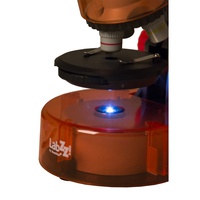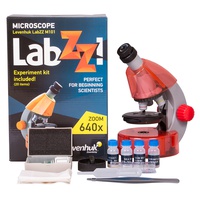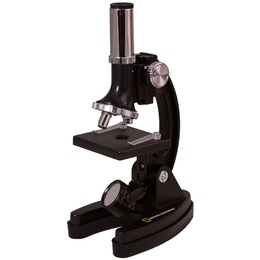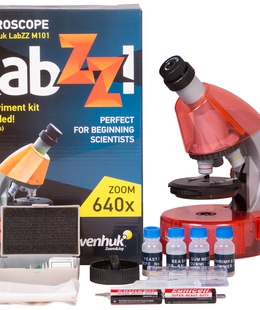Mikroskops bērniem, Levenhuk LabZZ M101 Orange, 40x-640x, ar eksperimentu komplektu
- Pieejams:Ir noliktavā
- Preces kods:11-69731
- Piegāde
-
Ikmēneša maksājums: 0.00 EUR
41,00 €
Levenhuk LabZZ – jaunā zīmola mikroskops ir radīts speciāli jaunajiem mikropasaules pētniekiem. Levenhuk LabZZ mikroskopiem ir raksturīgs neparasti veidots korpuss skaistās caurspīdīgās krāsās: mēnessakmens, ametists, debesu zils un laims.
Katru modeli papildina eksperimentālais komplekts Levenhuk K50 Experiment Kit, kurā ietilpst viss nepieciešamai, lai veiktu neatkarīgos pētījumus mājās. Pievienotā krāsainā lietošanas pamācība būs interesanta un informatīva lasāmviela jaunajiem pētniekiem.
Levenhuk LabZZ mikroskopi ir aprīkoti ar trijām kvalitatīvām objektīva lēcām (4x, 10x, un 40x), WF10x-16x slīdošais divu pozīciju okulārs, un tas sniedz palielinājuma spēku līdz 640x. Kvalitatīva optika rada pētāmā objekta patiesi skaidrus, asus un dzīvei tuvus attēlus. Mikroskops ir aprīkots ar LED apgaismojumu, kuram ir mazā mērā variabls spilgtums, kas sniedz iespēju novērot paraugus cauri ejošā gaismā.
Levenhuk LabZZ M101 mikroskopa galvenās iezīmes:
- Krāsains bērnu mikroskops ar palielinājumu līdz 640x
- Oriģināli veidots plastika korpuss ir drošs un viegls
- Pieejams četrās skaistās krāsās
- Slīdošs divu pozīciju okulārs WF10x–16x
- Lietošanai ārpusē pateicoties bateriju nodrošinātajam apgaismojumam
- Energoefektīvs LED apgaismojums
- Levenhuk K50 eksperimentālajā komplektā ietilpst
Paramecium caudatum - your first friend from the microworld
11/21/2016
Paramecium caudatum is perhaps one of the first protozoans that a young naturalist would explore. These organisms live in fresh standing water. They can also be found in an aquarium, especially if it hasn’t been cleaned for a long time. My ciliate-shoes were taken from the aquarium. Of course, there are only a few ciliate-shoes in aquarium water – the possibility of finding one of them in your microscope’s eyepiece is extremely low. Therefore, we need to increase their concentration. To do so, take a jar (about 17 fluid ounces or 0.5 liters), fill it with aquarium water, put a small spoiled onion and banana peel inside. Put the jar in a warm dark place for 5 to 7 days (don’t close it with a lid).


Paramecium caudatum. Animation. Magnification: 64x.
The average size of Paramecium caudatum is 0.02 inches (0.5 mm). For locomotion Paramecium caudatum uses its cilia (about 15 thousand cilia cover its little body!). Moreover, it has two nuclei (a large macronucleus is responsible for nutrition, respiration, metabolism, etc.; and a small micronucleus – for reproduction). Paramecium caudatum feeds on bacteria or algae. The food is caught by an oral groove covered in cilia and then goes to the cell mouth. It is then digested in the digestive vacuole (gullet). Undigested leftovers are ‘thrown out in the open’ through an anal pore (cytoproct). To remove all excess water, our heroine has two contractile vacuoles. They work like pumps on a boat, pumping excess water out of its body. Paramecium caudatum maintains its slipper-like shape thanks to a special membrane (pellicle).
11/21/2016
Paramecium caudatum is perhaps one of the first protozoans that a young naturalist would explore. These organisms live in fresh standing water. They can also be found in an aquarium, especially if it hasn’t been cleaned for a long time. My ciliate-shoes were taken from the aquarium. Of course, there are only a few ciliate-shoes in aquarium water – the possibility of finding one of them in your microscope’s eyepiece is extremely low. Therefore, we need to increase their concentration. To do so, take a jar (about 17 fluid ounces or 0.5 liters), fill it with aquarium water, put a small spoiled onion and banana peel inside. Put the jar in a warm dark place for 5 to 7 days (don’t close it with a lid).


Paramecium caudatum. Animation. Magnification: 64x.
The average size of Paramecium caudatum is 0.02 inches (0.5 mm). For locomotion Paramecium caudatum uses its cilia (about 15 thousand cilia cover its little body!). Moreover, it has two nuclei (a large macronucleus is responsible for nutrition, respiration, metabolism, etc.; and a small micronucleus – for reproduction). Paramecium caudatum feeds on bacteria or algae. The food is caught by an oral groove covered in cilia and then goes to the cell mouth. It is then digested in the digestive vacuole (gullet). Undigested leftovers are ‘thrown out in the open’ through an anal pore (cytoproct). To remove all excess water, our heroine has two contractile vacuoles. They work like pumps on a boat, pumping excess water out of its body. Paramecium caudatum maintains its slipper-like shape thanks to a special membrane (pellicle).
Preces krāsa var atšķirties no attēlā redzamās. Produkta apraksts ir vispārīgs, tajā ne vienmēr ir minētas visas produkta īpašības.
Līdzīgas preces





































